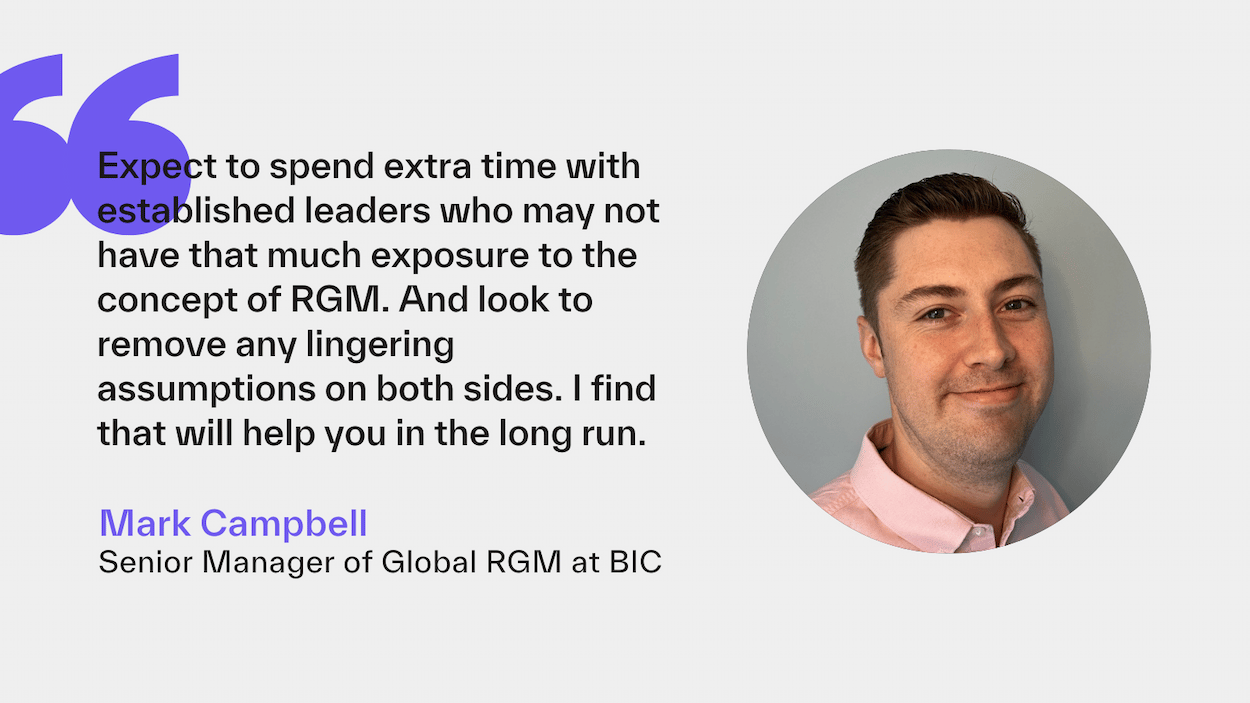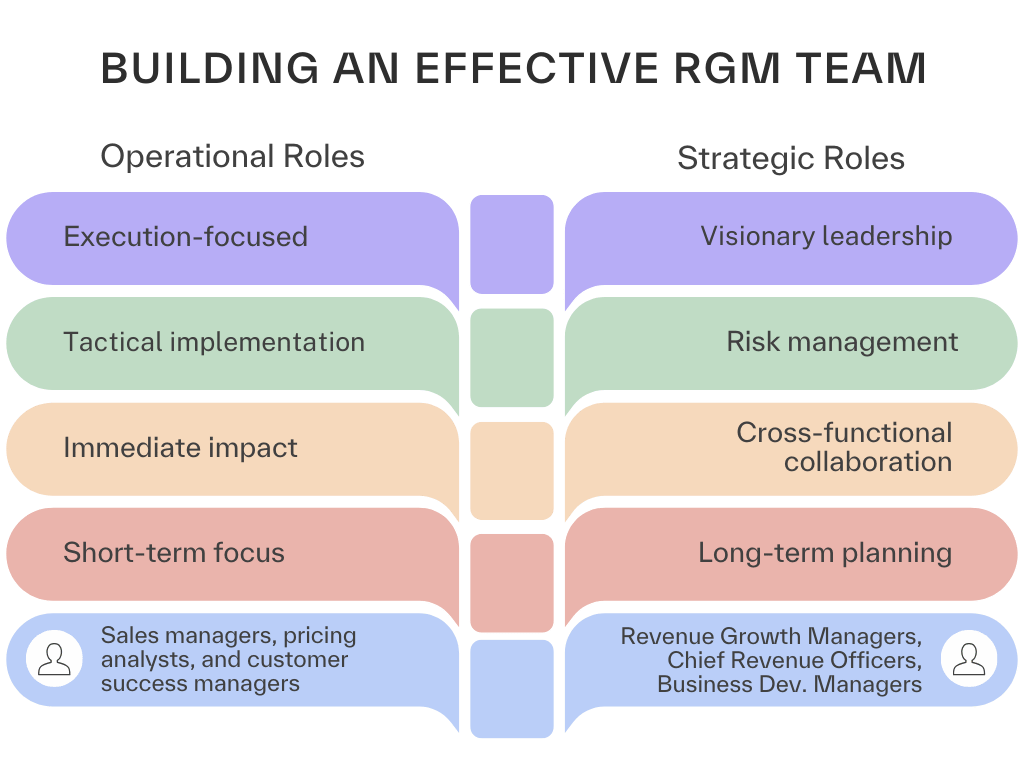BIC’s 10 Principles for Embedding an RGM Mindset
Whether you’re working in a well-established team or starting from scratch, there are common themes in revenue growth management (RGM) that drive success.
In this blog post, we will explore the 10 key principles of RGM according to Mark Campbell, Senior Manager of Global Revenue Growth Management at BIC, and how they help your company achieve your revenue growth goals.
- What are “key principles” and why do they matter?
- 10 principles of revenue growth management
- Empower your RGM team with the right support
What are “RGM key principles” and why do they matter?
RGM key principles are essential steps for embedding an RGM mindset within your organization. They involve various aspects, such as aligning on strategic goals, building a great team with the right skills, adopting a holistic approach to problem-solving, and more.
These principles aren’t silver bullet solutions, but rather fundamentals to have in place in your RGM team.
Having key principles matters because they provide a structured framework for RGM teams, ensuring alignment with your company’s strategic objectives and promoting consistency in decision-making and execution.
10 key principles of revenue growth management (RGM)
1. Align on the end state
When building an effective RGM mindset, you need to align on your end state. This requires thorough conversations with leadership to not only cover what the RGM team will deliver to the organization, but also how it will be delivered.
If you don’t clarify your end state, you risk misalignment and unmet expectations between your RGM team and corporate leadership.
To get started, focus on answering these questions:
- Over the next three years, what impact should the RGM team have?
- How do you intend for the RGM team to deliver this end state?
- Which processes do you want to have in place?
- Which behaviors and capabilities do you want to establish?

Ultimately, investing time and effort in aligning on the end state sets the stage for effective RGM implementation and long-term organizational growth.
2. Define your team's role
RGM teams sit across a spectrum. This ranges in terms of roles, functions, and sophistication level. Some teams operate with a narrow focus, solely managing pricing strategies, using traditional tactics, and limiting their collaboration across departments.
Others manage various aspects of revenue generation, including pricing, promotions, trade terms, and product mix. These teams may also leverage AI for data-driven decision-making and work closely with various stakeholders to align strategies to achieve revenue goals.
To successfully reach your end state, it’s important to establish what roles your team plays. Once you’ve decided your end state from the first step, answer the following questions to clarify roles:
- Is the RGM team accountable for results, or will these be delivered through others?
- Is the team focused on execution or transformation?
- What role does the team play in decision-making?
This will help you avoid assigning roles to your team that do not suit them at all, or in other words, “putting square pegs in round holes.”
3. Build the right team
Once you’re aligned on your team’s role, the next crucial step is to start building the right team with the necessary skills to help meet your end state.
First, it’s important to recognize the distinction between operational and strategic roles:

You risk overburdening your team if you expect them to deliver on both fronts, so you should ideally organize your team so that these roles are filled by the ones most qualified.
In short, your RGM team should ultimately be set up to deliver on your business objectives and strategy, be secure enough in their role to partake in decision-making and have the necessary influence and authority at your organization. However, this will look different from business to business.
4. Execute the basics
Once you’ve set your end goal and established your team, the next step is to make sure your RGM efforts align with the customer.
Executing the basics is essential in embedding an RGM mindset because it ensures commercial teams understand your RGM principles and apply them in customer interactions.
Successful commercial teams get on the customer’s level and are transparent when applying RGM. While the idea to understand and serve is not groundbreaking, the execution is notoriously difficult and requires continual effort and technology.
5. Utilize enough data
When leveraging data in RGM, less is more. The most successful approach to data acquisition and utilization is to not let your data lead your analysis.
By taking a minimum viable product approach to your data inputs, you assure that your organization is only buying the data you need.
This helps your team avoid falling into a long, unproductive “analysis paralysis” and allows them to focus on the outcome. To get started, rank your data sources according to how important they are in delivering your end state.
6. Be proactive
Since the COVID-19 pandemic, the majority of RGM teams have taken a 100% reactive approach. It’s quick and effective, but it’s not built for the long-term.
By being proactive, you’re better able to meet customer needs. In RGM, this means looking at the bigger picture to help your team build initiatives that are valuable to all parties.
Reactive approaches will always exist, especially when jumping from one unprecedented event to the other, but the teams that look beyond them will always be a step ahead.
7. Size the prize then prioritize
When your RGM team is stretched thin but you want to keep their performance high, the key is to focus on what is most crucial to growth.
This requires mapping out all opportunities and then choosing the priorities to focus on. To do this, you first need to develop a process for identifying and prioritizing the proactive opportunities you want to target.
The best approach is to create an exhaustive list of the initiatives you and your teams could be working on. From there, score each option according to a set list of criteria, ranging from attractiveness to success likeliness, to get an idea of what is feasible according to your deadline.
8. Think win-win-win
By taking on a triple-win approach, you create value for all stakeholders involved in the revenue growth process, namely shoppers, retailers, and manufacturers. It ensures that manufacturers and retailers are working toward the common goal of pleasing the shopper while remaining profitable and achieving strategic goals.
This involves prioritizing shopper needs and optimizing your strategies to meet them effectively, while also considering the growth agendas of retailers, wholesalers, and distributors. However, this can be challenging since it requires carefully navigating competing interests and strategic alignment across the value chain.
9. Adopt a holistic approach
Take a holistic approach to revenue growth instead of building siloed workstreams for single RGM levers. This helps your team consider all aspects of the business and how they can contribute to growth.
For instance, addressing customer mix issues may involve leveraging a combination of pricing, promotions, Price Pack Architecture (PPA), and trade terms to foster growth while preserving customer relationships.
By embracing this holistic perspective, organizations can optimize their RGM efforts and achieve sustainable results.
10. Measure the journey
Lastly, track your team’s progress toward revenue growth goals and make adjustments as necessary. By measuring progress, companies can ensure that they are on track to achieve their revenue growth goals.
Measuring the journey goes beyond just KPIs and financial targets. It should also incorporate tracking behavior, capabilities, and processes that were already aligned with leadership objectives.
To do this, it’s important to establish routines for regular feedback and course correction, both within the RGM team and across the wider commercial team. This will make sure that you are effectively working toward your end state, that your roles make sense, and that you are building the right team.
For more information on these ten principles for embedding an RGM mindset into your organization, check out our full webinar with BIC's Mark Campbell.
Empower your RGM team with the right support
From aligning on end goals to measuring progress, each of the principles above play a vital role in driving sustainable revenue growth at your organization.
However, adopting an RGM mindset is only half the picture. You need the right platform and support to effectively navigate your revenue growth journey and achieve your goals.
Buynomics is an AI-powered SaaS solution that makes your team more proactive and helps you effectively leverage your data to meet your end state. The platform offers a holistic approach to RGM, ensuring your team's success in today's competitive landscape and beyond.
Discover how Buynomics can elevate your RGM strategy and support your team today.
-1.png?width=50&height=50&name=Leah%20Liebl%20(1)-1.png)
February 28, 2024


